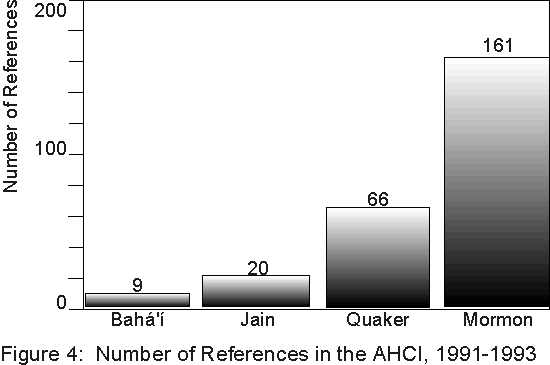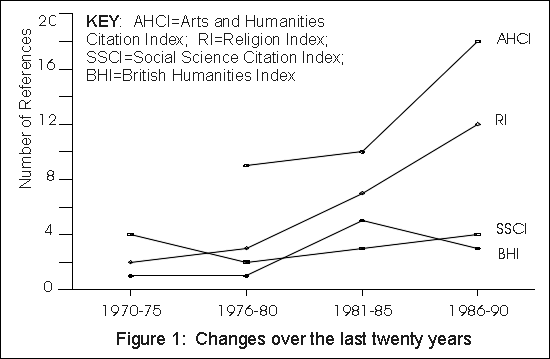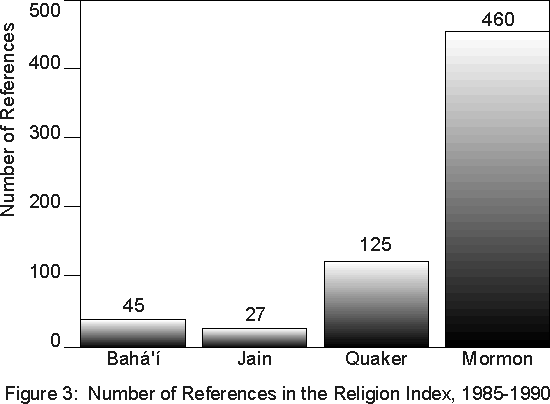
|
|
Abstract: The nature of the major indexes which classify periodical and journal articles by author and subject which are appropriate to Bahá'í studies and what they reveal about the state of the academic study of the Faith. Notes: |
Bahá'í Faith and Academic Journals
by Seena Fazel
published in Bahá'í Studies Review, 3:2London: Association for Bahá'í Studies English-Speaking Europe, 1993
The two largest and most comprehensive indexes are the Arts and Humanities Citation Index (AHCI) and the Social Sciences Citation Index (SSCI). They are both published annually by the Institute for Scientific Information (based in Philadelphia, USA). The AHCI is a multidisciplinary index to the literature of the arts and humanities with items from approximately 6100 of the world's leading journals included. The disciplines covered include theology and religious studies. The SSCI indexes items from 4700 journals.(1) These are both excellent and comprehensive resource materials enabling researchers, for instance, to access articles by keyword(s) in the title and by author.
A third reference volume is the British Humanities Index (BHI), published by the Library Association, London U.K., and is a guide to articles appearing in newspapers and journals published in Britain. The term 'humanities' is also interpreted broadly to include the arts, economics, history, philosophy, politics, and society. Unlike the AHCI and SSCI, newspaper coverage is included but this is restricted to comment and features on current affairs, and political and social criticism. Book reviews are not included.
There are now three religious journals and publications indexes. The first, Religion Index One: Periodicals(2) Religion Index Two: Multi-Author Works(3) indexes separately published works which are the works of more than 3 authors. About 432 books, and over 6000 articles were assessed for the 1990 edition. The Index to Book Reviews in Religion (Ed. E. Schaufler) completes the set of indexes. It was begun in 1986, and covers the same journals as Religion Index One.
It is worth noting that many of the periodicals and journals in which Bahá'ís have written are not catalogued, such as Iran, Bulletin of the British Society for Middle Eastern Studies (now British Journal of Middle Eastern Studies) and Iranian Studies, and consequently this information does not entirely reflect research on the Bahá'í Faith in non-Bahá'í periodicals. Also many relevant articles which do not have the word Bábís or Bahá'í in the title are not included.
There is also one Islamic research index, Index Islamicus (London: Mansell). The advantage of this index is that it includes a number of journals that the above indexes do not, such as the three above. It also lists chapters, books and monographs written on a specific subject; although this is very incomplete for Bahá'í publications.
The other useful tool in Bahá'í research is The Bibliography on the Bábí and Bahá'í Faiths 1844-1985, published by George Ronald (1990). The non-Bahá'í periodical section classifies all known mention of these Faiths in all English language journals and periodicals lacking emphasis on significant references in established journals that researchers would initially require in an academic study of the Bahá'í Faith.
The Bahá'í Faith features in all the indexes. From an analysis of this information, a number of conclusions may be drawn which are presented in the graphs below.
The number of references to the Bahá'í Faith in the indexes from 1980-1990 inclusive is as follows:
| Index | References |
| AHCI | 30 |
| SSCI | 8 |
| BHI | 8 |
| Religion Index | 71 |
| Religion Index,
excl. articles from World Order |
21 |
| Index Islamicus (articles only) | 21 |
It is notable that only about 26% of these references come from original papers (excluding the World Order articles). It is interesting that with the articles from World Order, the number of articles in the Religion Index is increased by 338%. It would then appear that The Journal of Bahá'í Studies is a serious omission from the all the indexes, and World Order from the AHCI and the SSCI. Both may be included if their editorial boards and Bahá'í academics write proposals to this effect.
Figure 1 charts the change over time in the number of Bahá'í references in the indexes. It shows that most indexes have seen a steady increase in the references to the Bahá'í Faith from the seventies. However much of this can be attributed to articles reporting the persecution of the Bahá'ís in Iran (17 references) and the Bahá'í temple in India (five references). Overall 35% of the entries on the Bahá'í Faith in the eighties are a consequence of these events. The implication is that the number of articles on the Faith will significantly decrease if the situation remains static.
|
|
Figures 2 and 3 compare the number of references to the Faith with some other religious movements in the AHCI and Religion Index from 1985 to 1990 inclusive. Jainism is chosen because its number of adherents is less than the Bahá'í Faith (3.6 million Jains compared to 5.3 million Bahá'ís according to "World Religious Statistics" in the 1991 Brittanica Book of the Year). Also the number of countries to which it has spread is significantly less than the Faith (10 compared to 205 countries). Although Jainism is a much older religion, one would nevertheless expect that there would be more articles on the Bahá'í Faith. However, as the graph shows, there have been 16 more articles on Jainism in the AHCI from 1985 to 1990.
The same conclusion can be drawn from these graphs. The Bahá'í Faith is suffering from a major dearth of academic literature. Mormonism, for instance, which has in excess of 8 million followers and is of comparable age historically, has had over sixteen times the number of articles written about it in these journals. This does little to support the efforts of Bahá'ís and their institutions to cultivate opportunities so that the Faith can be introduced into university and college curricula. And as Figure 4 demonstrates, the situation has actually got worse in last three years (1991-1993 inclusive).

|
A useful part of the AHCI and the SSCI is the ability to obtain information
on various authors by looking at the number of citations that they have
received in various articles. This is considered by some an important element
in judging the relative standing of scholars in a particular field. The
articles/books/theses may have written at any time, in any journal, but
they are included only if cited in the journals covered by the AHCI between
1981-1993 inclusive. Analysis of the AHCI from 1981 to 1993 provides the
following information:(4)
| Author | No. of citations on the Bábí- Bahá'í Faiths | Total no. of citations |
| Amanat, A. | 10 | 18 |
| Cole, J.R.I. | 3 | 34 |
| Hatcher, W.S. | 0 | 4 |
| MacEoin, D. | 22 | 31 |
| Martin, D. | 4 | 4 |
| Momen, M. | 21 | 40 |
| Smith, P. | 23 | 23 |
There are also two indexes to university theses which can now be accessed on CD-ROM. The University Microfilms International Dissertation Abstracts On disc has included most North American theses from 1861 to date. There is only one reference to the Bahá'í Faith - the PhD dissertation by J.E. Bartlett in 1984 (Bahá'í World Faith: A Case Study in Adult Socialization; University of California, Riverside). There are two references to the Bábí Faith - B.T. Lawson's PhD in 1987 (The Qur'án Commentary of Sayyid 'Ali Muhammad, The Báb; McGill University) and a study by M.R. Afshari (A Study of the Constitutional Revolution within the Framework of Iranian History; Temple University, 1981; PhD).(5) The Index to Theses: Great Britain and Ireland classifies dissertations from 1970 to 1990. This makes mention of Peter Smith's PhD on A Sociological Study of the Bábí and Bahá'í Religions (Lancaster University, 1982). Clearly both of these indexes fail to include a significant number of important dissertations.(6)
The overall impression given by this research is that the academic study of the Bahá'í Faith in non-Bahá'í periodicals is not thriving. This is not a particularly original finding. A 1989 article surveying the achievements of the Bahá'í community indicate that one of the present problems of the Bahá'í community is intellectual:
- Despite the recent increase in the attention paid to
Bahá'í scholarship, there is a general paucity of systematic
studies of Bahá'í doctrine. Despite - perhaps because of
- the great wealth of authoritative Bahá'í texts, there are
few studies of Bahá'í theology and philosophy.(7)
It is also of interest that the recent emphasis placed on correlating the Bahá'í Faith to social principles and contemporary needs has not translated itself into the academic literature. The vast majority of articles appearing in these journals are on Bahá'í history and theology. Social psychology makes a small contribution.(8)
Surprisingly there is not even one paper on the Bahá'í approach to peace issues or international relations. This, of course, is not the state of affairs in the Bahá'í community where there are many conferences, publications and books exploring the Bahá'í approach to current social problems.
For Bahá'í scholars, this information on how the Bahá'í Faith emerges from these academic indexes has a number of corollaries. The first is that they should be informed of this literature. A number of recent articles address concerns that need to be met. For instance, Aflatooni's review of The Bábí and Bahá'í Religions by Smith highlights what he considers to be a serious omission -- the "issue of the exclusion of women from the highest Bahá'í administrative body, the Universal House of Justice. For some reason Professor Smith does not touch on this question".(9) Another example is an article in Faith Freedom: A Journal of Progressive Religion where the author depicts an anti-liberal tradition in Bahá'í history and concludes that ". . . unity [has been] maintained at a great price, and now through a form of democratic centralism".(10) Also the repeated, though debatable, assertion that the Bahá'í Faith is a "new religious movement" rather than a world religion is made in a number of articles by MacEoin.(11) German-speaking Bahá'í scholars should be acutely aware that a recent introductory book by Francesco Ficicchia, a covenant-breaker, has been reviewed positively in a number of journals. One reviewer describes it as "a thorough study . . . based on a comprehensive study of the sources". Another supports the contention made by the publishers that it is "a standard work of comparative religion".(12)
In addition, Bahá'í scholars may consider submitting proposals to some of the indexes to include The Journal of Bahá'í Studies and World Order. Academically trained Bahá'ís may also decide to write more articles and book reviews for academic journals.
Of relevance to this discussion is a consideration of some of the reasons that may have led to the the lack of academic writing on the Faith. Hopefully this may serve to stimulate consultation on how to improve the situation. The non-Bahá'í scholar may consider it not worthy of serious study for a number of reasons but in the Bahá'í community, these reasons may include:
- In some quarters, there is the belief that an academic approach to the Bahá'í Faith is inappropriate. This attitude is put succinctly in a recent article: ". . . there are always fundamentalist elements in any religious community that deny the need for delving into and analyzing their religion".(13)
- The scarcity of Bahá'ís studying theology, philosophy and Islamic Studies at undergraduate and post-graduate levels.
- The idea that Bahá'í scholarship is for the future while the present challenge is teaching.(14)
- The lack of full-time funding or research facilities.(15)
- The emphasis in the last decade to apply Bahá'í principles to current social problems with a concomitant neglect of the Bahá'í approach to some important contemporary theological and philosophical problems.
- On the whole, Bahá'í books which are published are aimed at a general Bahá'í market or they are introductory books for non-Bahá'ís. As the market cannot sustain academic books, consequently there may be a reluctance to publish this sort of material.(16) This not only seriously hampers the development of Bahá'í studies but also interferes with the goal of teaching prominent people - an important priority for the international Bahá'í community.
[Note: This is an updated and revised version of a paper published in the
Bahá'í Studies Bulletin 6.2-3 (1992). I am grateful to Stephen Lambden
for his comments on earlier drafts of this paper.]
End Notes
- Within the U.K., both of these can now be accessed from computer networks through the Institute for Scientific Information Data Service at Bath, twenty-four hours a day, seven days a week.
- 2. Ed. D. Haynes. Evanston: America Theological Library Association. It began in 1969, and is published annually.
- 3. Ed. E. Treesh. Begun in 1960, published annually.
- 4. This represents a correction from the previous version of this article which was published in Bahá'í Studies Bulletin. The latter was a source index while this is a citation index.
- 5. This reference has not been noted by Collins or in any other Bahá'í publications. The abstract contains the following passage: "Throughout the rest of the study attention is focused on the role played by the pishevaran and merchants in the Bábí Revolt, the Tobacco Protest Movement and the Constitutional Revolution and parallels are drawn, wherever possible, between these movements and between them and traditional revolts in Iranian history."
- 6. For a list of other PhD theses, see Collins' Bibliography 303-310.
- 7. Smith, P. and Momen, M. "The Bahá'í Faith 1957-1988: A Survey of Contemporary Developments", Religion 19 (1989): 63-91.
- 8. See, for example, Ullman, C. Cognitive and emotional antecedents of religious conversion. J. Pers and Social Psychology 43.1 (1982):183-192; Ebaugh, H.R. and Sharron, L. Ideology and recruitment in religious groups. Rev Rel Res 26 (1984):148-157; Ebaugh et al. Life crises among the religiously committed: do sectarian differences matter? J Sci St Rel 23 (1984):19-31.
- 9. In Review of Religious Research 30.1 (1988): 110-111.
- 10. Worsfold, A. "Peace, Liberalism and Otherwise in the Bábí-Bahá'í Faiths", Faith Freedom: A Journal of Progressive Religion 42 (1989): 40-44.
- 11. See for instance MacEoin, D. "Bahá'ísm: a religious revolution in the making?" New Humanist 102 (1987): 9-11.
- 12. Henninger, J. "Bahá'ísmus, A world religion of the future", by F. Ficicchia. Anthropos 78.5-6 (1983): 936-939; and Kleimkeit, H.J. "Bahá'ísm - global religion of the future - History, teaching and organization in a critical inquiry", by F. Ficicchia. Zeitschrift fur religions und Geistesgeschichte 36.1 (1984): 93-94. See also Schumann, O. in Islam: Zeitschrift fur Geschichte und Kultur des Islamischen Orients 62.1 (1985): 184-186. I am grateful to Morten Bergsmo for these translations from German.
- 13. Momen, M. "Scholarship and the Bahá'í Community", The Journal of Bahá'í Studies 1.1 (1988): 26.
- 14. This is further discussed by S. Lambden in Bahá'í Studies Bulletin 3.3 (1983): 82-86; "The concrete support of Bahá'í scholarship would have important consequences for internal Bahá'í 'deepening' and external Bahá'í 'teaching'. It would serve to enable certain individuals to be more adequately informed about their Faith and enable them to befittingly communicate it to others. It would also equip individuals to 'defend their Faith' against distorted and hostile misrepresentations..."
- 15. See Lambden, S. "Some thoughts on the establishment of a permanent Bahá'í Studies Centre and Research Institute", Dialogue (1988): 34-40.
- 16. If one uses the books reviewed in non-Bahá'í academic journals as a crude indicator of the number of scholarly books published from 1970-1993, Bahá'í publishers have had the following number of their books reviewed in academic journals:
Publisher No. Books
ReviewedTotal No.
ReviewsGeorge Ronald 10 16 Kalimat Press 8 13 Oneworld 2 2 American BPT 1 1 British BPT 0 0 It is of interest that the four books published by non-Bahá'í companies (by Amanat, Hatcher and Martin, Hakime, and Smith) received more book reviews than all the Bahá'í books combined. See my note on "Reviews of Books on the Bábí-Bahá'í Religions in Academic Journals, in Associate, newsletter of the ABS-ESE, no. 7 (Jan 1993): 4-5.
|
|


